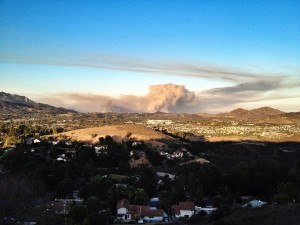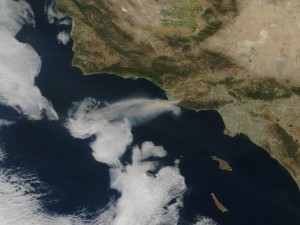8 July 2015
WASHINGTON, D.C. – Southern Californians and writers love to blame the hot, dry Santa Ana winds for tense, ugly moods, and the winds have long been associated with destructive wildfires.
Now, a new study finds that on occasion, the winds have an accomplice with respect to fires, at least: Natural atmospheric events known as stratospheric intrusions, which bring extremely dry air from the upper atmosphere down to the surface, adding to the fire danger effects of the Santa Anas, and exacerbating some air pollution episodes.
The findings suggest that forecast models with the capacity to predict stratospheric intrusions may provide valuable lead time for agencies to issue air quality alerts and fire weather warnings, or to reallocate firefighting resources before these extreme events occur.
“The atmosphere could give us an early warning for some wildfires,” said Andrew Langford, a research chemist at the National Oceanic and Atmospheric Administration’s (NOAA) Earth System Research Laboratory in Boulder, Colorado, and lead author of the study.
Researchers at NOAA’s National Environmental Satellite, Data, and Information Service (NESDIS) and the Cooperative Institute for Research in Environmental Sciences (CIRES) at CU-Boulder coauthored the work, which has been accepted for publication in Geophysical Research Letters, a journal of the American Geophysical Union.

The May 2013 “Springs Fire” burned 25,000 acres northwest of Los Angeles. A new study finds that natural atmospheric events known as stratospheric intrusions, which bring extremely dry air from the upper atmosphere down to the surface, add to the fire danger effects of the Santa Ana winds, and exacerbate some air pollution episodes.
Credit: Night Owl City/Flickr
The authors took a detailed look at the May 2013 “Springs Fire” that burned 100 square kilometers (25,000 acres) about 75 kilometers (50 miles) northwest of Los Angeles. The researchers used a NOAA forecast model that incorporates satellite observations of ozone, wind data, and other atmospheric information to detect the occurrence of the intrusions.
The analysis showed that in the early hours before the Springs Fire, a tongue of air characteristic of the stratosphere—extremely dry and very high in ozone from the stratosphere’s ozone layer—reached to the surface in southern California and extended as far south as Baja California.
The researchers found that ground-based monitoring stations near the fire’s origin also confirmed the telltale signs of the intrusion right before the fire broke out: A large drop in relative humidity and a rise in ozone. As the day went on, a combination of factors accelerated the fire: Low humidity, persistent high winds, dry condition of the grasses and other vegetation, clear skies and bright sunlight, and very warm surface temperatures. A few days later, cloudy skies, a drop in temperature, a shift in winds, and widespread rainfall helped extinguish the fire.
The stratospheric intrusion also had another downside during the Springs Fire: It added ozone from the upper atmosphere to the urban and fire-related pollution produced in the lower atmosphere. On the second and third days of the fire, this helped to push levels of ozone—which can harm people’s lungs and damage crops—over the federal ozone limit at 24 monitoring sites across southern California. Monitors as far away as Las Vegas also saw a spike in ozone on the third day of the fire. The observed exceedances of the ozone standard were unusual for the region for that time period, suggesting that the stratospheric intrusions were a contributing factor.

Satellite image of the smoke on 2 May 2013, the first day of the Springs Fire northwest of Los Angeles.
Credit: NASA
“Stratospheric intrusions are double trouble for Southern California,” said Langford. “We knew that the intrusions can add to surface ozone pollution. Now we know that they also can contribute to the fire danger, particularly during La Niña years when deep intrusions are more frequent, as recently shown by our NOAA colleagues at the Geophysical Fluid Dynamics Laboratory. The good news is that with models and observations, we can get an early warning from the atmosphere in some cases.”
The authors note that stratospheric intrusions have previously been implicated in the explosive development of wildland fires in New Jersey and Michigan, but have not previously been connected to fires in southern California or to the Santa Ana winds. The frequent occurrence of stratospheric intrusions above the west coast during the fall, winter, and spring suggests that similar circumstances may have played a role in other major southern California fires, including the series of destructive fires that burned more than 3,000 square kilometers (more than 800,000 acres) in October of 2003, and burned about 4,000 square kilometers (nearly a million acres) in October of 2007, say the authors.
###
The American Geophysical Union is dedicated to advancing the Earth and space sciences for the benefit of humanity through its scholarly publications, conferences, and outreach programs. AGU is a not-for-profit, professional, scientific organization representing more than 60,000 members in 139 countries. Join the conversation on Facebook, Twitter, YouTube, and our other social media channels.
CIRES is a partnership of NOAA and CU-Boulder.
Notes for Journalists
Journalists and public information officers (PIOs) of educational and scientific institutions who have registered with AGU can download a PDF copy of the article by clicking on this link: http://onlinelibrary.wiley.com/doi/10.1002/2015GL064964/full?campaign=wlytk-41855.5282060185
Or, you may order a copy of the final paper by emailing your request to Nanci Bompey at [email protected]. Please provide your name, the name of your publication, and your phone number.
Neither the papers nor this press release is under embargo.
“Stratospheric intrusions, the Santa Ana winds, and wildland fires in southern California”
Authors:
A.O. Langford: NOAA Earth System Research Laboratory, Boulder, Colorado, USA;
R.B. Pierce: NOAA/NESDIS Center for Satellite Application and Research, Cooperative Institute for Meteorological Satellite Studies, Madison, Wisconsin, USA;
P.J. Schultz: NOAA Earth System Research Laboratory, Boulder, Colorado, USA; and Cooperative Institute for Research in Environmental Sciences, University of Colorado, Boulder, Colorado, USA.
Contact Information for the Authors:
Andy Langford: +1 (303) 809-0458, [email protected]
Nanci Bompey
+1 (202) 777-7524
[email protected]
CIRES Contact:
Katy Human
+1 (303) 735-0196
[email protected]
NOAA Contact:
Monica Allen
+1 (301) 734-1123
[email protected]